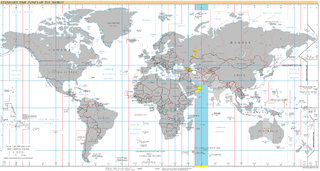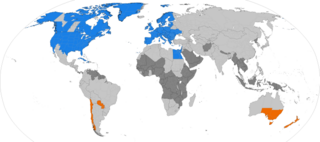
Moscow Time is the time zone for the city of Moscow, Russia, and most of western Russia, including Saint Petersburg. It is the second-westernmost of the eleven time zones of Russia. It has been set to UTC+03:00 without DST since 26 October 2014; before that date it had been set to UTC+04:00 year-round on 27 March 2011.

UTC+10:00 is an identifier for a time offset from UTC of +10:00. This time is used in:

UTC+11:00 is an identifier for a time offset from UTC of +11:00. This time is used in:

UTC+09:00 is an identifier for a time offset from UTC of +09:00.

UTC+03:00 is an identifier for a time offset from UTC of +03:00. In areas using this time offset, the time is three hours later than the Coordinated Universal Time (UTC). Following the ISO 8601 standard, a time with this offset would be written as, for example, 2019-02-08T23:36:06+03:00.

UTC+05:00 is an identifier for a time offset from UTC of +05:00. This time is used in:

UTC+04:00 is an identifier for a time offset from UTC of +04:00. In ISO 8601, the associated time would be written as 2019-02-07T23:28:34+04:00. This time is used in:

Omsk Time (OMST) is a time zone in Russia that is six hours ahead of UTC (UTC+06:00), and 3 hours ahead of Moscow Time (MSK). It is used in Omsk Oblast.

There are 11 time zones in Russia, which currently observe times ranging from UTC+02:00 to UTC+12:00. Daylight saving time (DST) has not been used in Russia since 26 October 2014. From 27 March 2011 to 26 October 2014, permanent DST was used.

Time in Brazil is calculated using standard time, and the country is divided into four standard time zones: UTC−02:00, UTC−03:00, UTC−04:00 and UTC−05:00.
Time in Chile is divided into three time zones. Most of Continental Chile uses the time offset UTC−04:00 in winter time and UTC−03:00 in summer time, while the Magallanes and Chilean Antarctica region uses the time offset UTC−03:00 the whole year. Additionally, Easter Island uses the time offset UTC−06:00 in winter time and UTC−05:00 in summer time.
This is a list of the administrative and municipal divisions of Moscow Oblast, a federal subject of Russia.

Magadan Time (MAGT) is a time zone in Russia, named after Magadan, the administrative center of Magadan Oblast. It is 11 hours ahead of UTC (UTC+11) and 8 hours ahead of Moscow Time (MSK+8).

Samara Time (SAMT) is the time zone four hours ahead of UTC (UTC+4) and 1 hour ahead of Moscow Time (MSK+1). Samara Time is used in Astrakhan Oblast, Samara Oblast, Saratov Oblast, Udmurtia, and Ulyanovsk Oblast.

Yakutsk Time (YAKT) is a time zone in Russia which is nine hours ahead of GMT, and six hours ahead of Moscow Time (MSK).

Vladivostok Time (VLAT), is a time zone in Russia, named after the city of Vladivostok. It is ten hours ahead of UTC (UTC+10:00) and seven hours ahead of Moscow Time (MSK+7).

Kamchatka Time or Petropavlovsk Time (PETT; Russian: камчатское время, kamchatskoye vremya), also known as Anadyr Time (ANAT), is a time zone in Russia, named after the Kamchatka Peninsula. It is 12 hours ahead of UTC (UTC+12:00) and 9 hours ahead of Moscow Time (UTC+12:00). This time zone is used in the two easternmost regions of Russia after October 2014 and was also used before the time zone reform of 2010.

As of 2022, daylight saving time is used in the following Asian countries:

Daylight saving time (DST), also known as summer time, is the practice of advancing clocks during part of the year, typically by one hour around spring and summer, so that daylight ends at a later time of the day. As of 2024, DST is observed in most of Europe, most of North America and parts of Africa and Asia around the Northern Hemisphere summer, and in parts of South America and Oceania around the Southern Hemisphere summer. It was also formerly observed in other areas.











